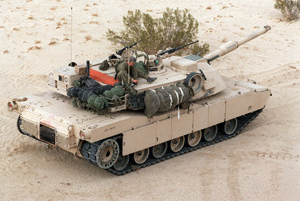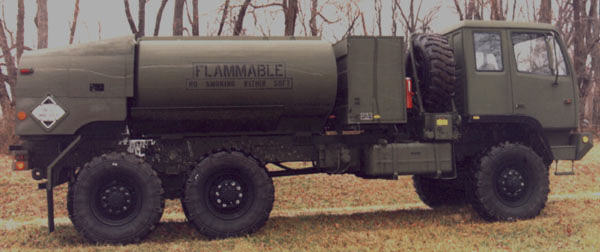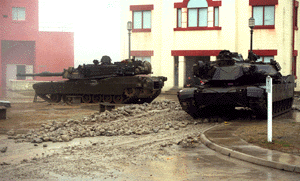 The
goal of tank engine development has always been "more power". The
M1A1 Abrams tank with its revolutionary gas turbine engine was designed to fight massed Soviet armor in a rapid, bloody confrontation.
Fuel economy was not important since tanks were based less than 100 miles from the enemy.
These tanks are a great assets, but they need to be upgraded for expeditionary and urban operations by replacing their gas turbine engine with a
diesel engine, resulting in four major advantages:
The
goal of tank engine development has always been "more power". The
M1A1 Abrams tank with its revolutionary gas turbine engine was designed to fight massed Soviet armor in a rapid, bloody confrontation.
Fuel economy was not important since tanks were based less than 100 miles from the enemy.
These tanks are a great assets, but they need to be upgraded for expeditionary and urban operations by replacing their gas turbine engine with a
diesel engine, resulting in four major advantages:
#1 The gas turbine is a fuel hog
The gas turbine engine provides unmatched acceleration, but consumes a lot a fuel. Estimates vary, but the combat average (not highway cruise average) from various sources is about three gallons per mile (not miles per gallon). This is about three times more than similar diesel engines. A diesel engine with three times the fuel efficiency could triple the range of Abrams tanks. The Abrams looks great charging across the desert at high speed during peacetime exercises, but this is impractical on most of the earth's surface. Wise tankers generally advance at a steady pace, lest they get ambushed.
The U.S. Army did a couple of high speed tank assaults in Iraq, but the outcomes of those rare confrontations would have been the same if the Abrams tanks moved slower. A slower overall tactical speed would have been compensated by a better operational speed, e.g. if tanks didn't need to halt and wait for refueling. During Operation DESERT STORM, the U.S. Army's VII Corps had to stop and wait for refueling trucks for thirsty Abrams tanks at a critical moment, and much of the Iraqi Republican Guard was able to escape. Ideally, more reliable fuel-efficient diesel engines will also reduce the need for tractor-trailers to transport tanks in-theater, like was done in Saudi Arabia.

In Germany, fuel was moved from the nearby fuel depot. In expeditionary operations, fuel may have to come all the way from California. It makes a big difference if three oil tankers are needed to fuel gas turbine powered tanks for an armored division each week, or just one tanker for a division with diesel engines. Since the fuel the must be delivered, a gas turbine powered division requires three times more fuel trucks, and another tanker a week just to provide fuel for the extra trucks. Then there are the soldiers and equipment needed to offload and store the fuel, and three times more logistical support for three times more truck drivers, and three times more truck mechanics.
#2 The gas turbine's infra-red signature is huge
Infra-red technology made quantum advances over the three decades since the Abrams was designed. The Abrams gas turbine engine puts out 1000F degrees of heat, four times more than diesel engines. As a result, they can be detected and targeted much farther away, and take much longer to cool down when a tank needs to hide. In addition, this allows an enemy to easily distinguish the big bright plume of an Abrams tank from a truck or any other engine.
This has become a greater problem with new infra-red guided munitions. Many modern anti-tank missiles, artillery and mortar rounds use infra-red sensors to detect engines. Obviously, a tank producing four times more heat is four times more likely to attract attention and incoming munitions. The Abrams tank produces so much heat that it could probably be destroyed from the rear by diving jet aircraft firing heat-seeking anti-aircraft missiles.
#3 Engine heat limits the Abrams in supporting urban operations
 The engine heat causes problems in tank/infantry tactics against
fortified areas and in urban terrain. The standard tactic is for tanks to
crawl forward blasting anything that moves while infantry follows close behind and on
top of tanks to protect their vulnerable top, flank and rear areas. M-60
tanks even have a standard telephone receiver outside so infantry leaders can talk to the tankers.
Any
gunman popping out of a door, window, or hole was
promptly gunned down by this team.
The engine heat causes problems in tank/infantry tactics against
fortified areas and in urban terrain. The standard tactic is for tanks to
crawl forward blasting anything that moves while infantry follows close behind and on
top of tanks to protect their vulnerable top, flank and rear areas. M-60
tanks even have a standard telephone receiver outside so infantry leaders can talk to the tankers.
Any
gunman popping out of a door, window, or hole was
promptly gunned down by this team.
However, the Abrams blows out 1000F degree heat from its rear, making it impossible for infantrymen to follow behind or ride on top. Since the U.S. military has recognized the need to prepare for urban warfare, it needs to recognize this problem.
#4 The gas turbine engine is very expensive
A big secret in the US Army is that the Abrams gas turbine is expensive to maintain and replace. The Army devotes 25% of its annual maintenance budget for all ground combat systems to Abrams gas turbine engines, and other 25% to the rest of the tank. Diesel engines are much cheaper, more reliable, and require less maintenance.
The M1A3 tank is key to the U.S. Army's future
It has become fashionable to declare "the tank is dead". This is false, no weapon system can provide more immediate direct firepower than a tank. Tanks are essential for urban operations and to flush out entrenched infantrymen. However, tanks are less important on the modern battlefield, particularly in open terrain where airpower rules. Tank battalions are outdated, placing 58 tanks (now 45) in a solid tank battalion is overkill. Army "heavy" (e.g. major battle) armor/mech divisions must shed about one-third their tanks, down to about 100 tanks each.
Overall, the US Army should plan an M1A3 upgrade program for about 2000 tanks, including those in the National Guard and pre-positioned stocks. The Army has amassed 8000 M1 series tanks, most are surplus and maintained in storage. The Army should scrap 6000 of these tanks and cannibalize them for billions of dollars in spare parts. The Army should not award profitable contracts to perform this task, it only needs to park a a few hundred surplus Abrams tank near each heavy division and tell the mechanics to take whatever they need.
 Diesel engines should be installed as part of an M1A3 upgrade program. Selecting
a diesel engine is simple since the Perkins CV12 engine (left) rated at
1500bhp had been selected for the US Army's Crusader field artillery
system, or the Detroit Diesel 1500bhp which powers Israeli Merkava tanks could
be bought. However, American industry makes numerous smaller engines
which the Army may select for even greater fuel efficiency.
Diesel engines should be installed as part of an M1A3 upgrade program. Selecting
a diesel engine is simple since the Perkins CV12 engine (left) rated at
1500bhp had been selected for the US Army's Crusader field artillery
system, or the Detroit Diesel 1500bhp which powers Israeli Merkava tanks could
be bought. However, American industry makes numerous smaller engines
which the Army may select for even greater fuel efficiency.
Putting a different engine in 2000 Abrams tanks will not be cheap, but could be if combined with a multi-year upgrade program. The Army's M1A2 upgrade program is an expensive disaster, costing $6 million dollars for some electronic upgrades for EACH Abrams tank. An M1A3 program with a diesel engine, improved secondary armament, gun shields, GPS, a commander's thermal viewer, exterior telephone, a tank roof, and service life extension overhaul should cost less than a million dollars each, and the Army would immediately begin to save money from fuel for training and engine maintenance costs.
The gas turbine engine seemed like a good idea in the 1970s, but the world has changed; no other army in the world adopted the gas turbine engine for tanks. In fact, the Germans are producing a MTU diesel engine for the proposed M1A1 sale to Turkey. The M1A2 tank is a great tank, but an M1A3 would be much better for future operations.
Carlton Meyer editorG2mil@Gmail.com
Update
The Army's response to this idea of tripling the gas mileage for its tanks was to ignore it, and has now proposed gas turbine engines for its Crusader artillery gun. I just found a March 31, 2000 press release from General Dynamics about its tests of an M1A2 tank operating a diesel engine. They want to sell M1A2 tanks to the Turks, but they are too smart to want the gas turbine engines. General Dynamics found the tests successful, and proclaimed: "The tank moves as well as the standard turbine-powered tank with no difference in target detection, identification or main gun accuracy. The testing confirms that the tank's performance is not changed by the diesel engine and that it has a significantly lower operating cost".
A May 2001 study by the Defense Science Board "More Capable Warfighting Through Reduced Fuel Burden" noted that fuel makes up 70% of the cargo tonnage needed to position the US Army in battle. The study said that if M1A1 tanks were 50% more fuel efficient , the Persian Gulf War buildup could have been 20% faster and ground forces ready to fight one month sooner. They noted that a fuel delivered by ocean tankers costs only around $1 a gallon at the port, but transporting it inland can drive the cost up to $50 a gallon.
Letters
M1 Diesel Upgrade
I enjoyed your article about a possible M1A3 upgrade very much and must say that I agree with you almost fully. The thing that I disagree on is that you say that a smaller engine than 1500 bhp (like the 1050 bhp engine you referred too) can be adopted for a tank like the M1. I don't believe that a tank as heavy as the M1 is helped by that decrease in speed and acceleration. The Swedish Leopard 2/Strv 122 with its 12 cylinder 1500 hp diesel MTU engine had the lowest diesel consumption compared to the rest of the tanks during the Hellenic Tank Clash... You know where the Greeks compared the modern MBTs...
1050 hp is simply too low I think. Other than that you make a strong case too
introduce the M1 into the diesel community. I also agree on your reasoning about
urban warfare. Close interaction with own infantry is needed to achieve safe
passage for the entire unit. This was proven during my battalion's last exercise
where we fought a FIBUA scenario... The tanks companies got beaten pretty hard
before they could get through. This much because of the lack of close infantry
support.
Peter Eriksson
viggen80@hotmail.com
http://home.swipnet.se/tanks
Diesel switch not so simple
The decision to buy a turbine engine tank was a political decision. The
Army had intended to select the GM version, which had a diesel engine.
However, at the eleventh hour, The DepSecDef apparently ordered the Sec Army to
reverse the decision and select the Chrysler version, which had the gas turbine
engine. You may recall that, at the time, Chrysler was in serious
financial difficulty. Indeed, it is arguable that had Chrysler not been
able to later sell their tank unit to General Dynamics for $650 million, they
might have
gone bankrupt.
As for converting the M1 to a diesel engine, not so fast. When the M1 was first fielded in the Germany, there were serious operability problems during the winter months due to diesel fuel waxing that plugged the turbine engine fuel filters. The Army's solution to the problem was to convert to the use of JP-8, which became available at the time due to efforts by the Air Force and Army aviation to eliminate JP-4. The Army now runs nearly all of it's TO&E equipment on JP-8.
That said, conversion to a diesel engine powered tank would, in my mind, suggest
another fuel conversion as the diesel tank engine would certainly perform better
running on diesel fuel. Thus the price of poker is not merely an engine
replacement program, but also conversion of a major portion of the Army and
Defense Logistics Agency's petroleum infrastructure/ war reserve fuel stocks as
well. How many USMC spaces do you suggest we give up to pay for that?
Steve Bliss
BG, USA (Ret)
Ed. That's a good point, but it would take years to convert to diesel, so it should cost little with long-range planning. In addition, the war stocks could be cut if less fuel is needed, and diesel engines immediately save money in fuel training costs. The best way to solve the shortfall in CSS units is to reduce CSS requirements.
Hybrid Tank Engines
Excellent article on replacing turbine tank
engines with diesel. Have you also considered that the benefits you
mentioned could be improved even more by using a hybrid diesel-electric
engine? As you probably know, a hybrid engine uses a conventional engine
(diesel, gasoline, piston, rotary, turbine, etc.) along with an electric motor
to assist during peak power requirements, drawing on batteries which are
constantly recharged by the engine.
http://www.ott.doe.gov/hev/hev.html
With this configuration, the diesel engine need only
be sized to meet cruising power requirements, and can operate all the time at
its most effective speed or be turned off entirely during idle, resulting in
significant fuel savings. A hybrid electric engine can also be operated
in electric-only mode, bringing not only the infrared, but also the acoustic
signature down to nearly nothing. We're not talking about pie-in-the-sky
future tech, either. Hybrid engines have been used for over 100 years,
beginning with early steam-electric cars, and most notably with submarines.
The Army is currently looking at a hybrid Hummer for many of the same reasons.
Eric Lewan
Ed. I think the hybrid Hummer is a great idea and is ready for
production; it was developed by
DARPA not the Army or Marines. I'm not sure what size batteries are
needed to drive a 70-ton tank, and that would require years of
"research", which is the Army's favorite way to delay changes.
I'd say press ahead with the proven diesel engine upgrade plans while
researching a hybrid.
The advantage of the diesel in a tank designed for one is real, but there is another issue in retrofitting the M1 family that you fail to address. The smallest diesel with the power and speed to drive this main battle tank is significantly larger and heavier than the turbine. In order to fit one in the chassis, something will have to be sacrificed, probably ammunition and fuel capacity, new suspension, new transmission, different final drives, etc. Detail studies done by BMY for DOA in the 1980's including trial fits produced a massive change list. And there was a minor issue of air transport which is limited to 70 tons, the weight of the current M1A2. In the end, the cost outweighed the benefits.
That said, the newest diesel technology will offer a advantages and it should be possible to install a current technology engine that is a major improvement. Dieselizing the tanks will also greatly simplify the logistics issues for the Army by having all of its vehicles running on one fuel, diesel. After all, all of the M88's, M2's, M109's, M992's, humvees, trucks, etc are all diesels. In fact, the M1's currently running in Iraq are probably using diesel fuel (with reduced performance) to simplify the supply problems. And diesel is cheaper to buy than JP-8. There is also the major advantage in combat of the ability of a diesel to sit idling with little fuel consumption while the M1 must shut down to save fuel. When the M1 was first fielded, the units found the M1 could last a single day under combat conditions before refueling whereas the M60 could go 3 to 4 days. If a column were caught by surprise, an idling M1 diesel would be able to respond while a turbine engined unit must still fireup. After all, the only other first class battle tank in the world is the British Challenger 2 which is a diesel.
And a final point of note, It might also be pointed out to DOD that the turbine engine is a major polluter, spewing NOx, CO and all sort of unpleasant things out in the air. Maybe you can get a tree hugger or two to help. After all, most Army vehicles are painted green.
Are we going to change the M1 A3 to a diesel? Probably not. Should we? yes.
James Barends